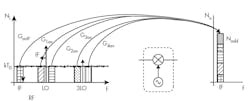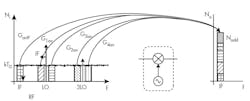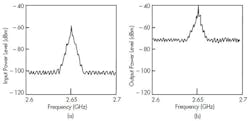What’s The Difference Between Noise Terms and Noise Generators?
This file type includes high resolution graphics and schematics when applicable.
Noise is everywhere—you can’t get rid of it, but rather can only hope to mitigate its effects in the signal chain. On top of that, noise isn’t consistent. A good system design, therefore, includes additional overhead to account for noise generators.
Many different types of noise generators exist both inside and outside of components and systems. As a result, engineers use many terms to describe noise based on what, when, where, and how it’s generated.
Noise is simply undesired energy outside of the signal that’s manipulated by a system’s design. Every component in a system generates noise. As such, there are terms to describe the noise contribution of a component and how it generates that noise.
Signal-to-noise ratio (SNR) compares the desired signal power to the noise power, or noise level, over a range of frequencies. SNR is typically given with respect to a frequency that relates to the operational frequency of a system. Usually, it’s “average” SNR rather than “instantaneous.”
The noise floor, or noise power, will sometimes be confused with the noise figure. Within a signal chain, the noise floor represents the total measure of noise energy present within a signal created from noise generators and unwanted signal sources. To specify the targeted noise floor, it’s categorized into the noise floor of both the test equipment (or instrumentation noise floor) and noise generators (or incidental noise). Incidental noise-floor conditions include temperature, atmospheric conditions, cosmic noise, and many other factors.
Too Much Noise!
Random thermal motion of charge carriers determines the thermal or Johnson-Nyquist noise generated within a conductor. Because thermal noise is basically white noise, it produces roughly equal power across the entire frequency spectrum. Unfortunately, every component within the signal chain will add to thermal noise within the signal. Therefore, it’s essential to account for this noise. Components or systems that suffer most from thermal noise can be cooled to lessen its impact. But this method usually incurs costs, size, and complexity tradeoffs.
In terrestrial environments, electron charge action within the atmosphere and weather patterns will generate noise. Lightning discharges and thunderstorms are the primary contributors. As long-range noise contributors, several atmospheric incidences can induce this type of noise simultaneously. Understandably, this is the justification for some high-priority satellite-communication systems that rely on multiple installations in geographically diverse locations.
Cosmic noise identifies closely to thermal noise in that many types of cosmic noise are ever-present. It includes cosmic microwave background radiation (CMBR), which may have been a product of the Big Bang and generally peaks in the microwave bands. Other examples of cosmic noise include solar activity and celestial objects inside and outside of our galaxy that emit electromagnetic (EM) radiation. Random celestial events can also induce unpredictable and often complex noise distribution, such as meteorites ionizing surrounding gases by entering our atmosphere, solar flares, and supernovae. Generally, shielding is the only way to mitigate comic-noise generators.
This file type includes high resolution graphics and schematics when applicable.
Other Noise Considerations
This file type includes high resolution graphics and schematics when applicable.
Another intrinsic noise generator to consider is flicker noise, 1/f noise, or pink noise. Flicker noise stems from direct current (dc) or resistive effects. One example is generation/recombination noise caused by the base current or inconsistencies in the conductive channel within a transistor or diode. Though predominantly a low-frequency phenomenon, flicker noise can occasionally be upconverted to frequencies within a significant range of the carrier frequency. For instance, this may occur during frequency generation or when mixer circuits are involved. Flicker noise can become significant in higher-current devices because its power tends to rise with increasing current.
Transit-time noise usually becomes an issue in frequencies above the very-high-frequency (VHF) band. This type of noise generates during amplification of a signal with a period that’s in the same order of magnitude as the traveling time required for electronics to go from the emitter to collector in a bipolar junction transistor (BJT). This effect increases the transistor’s noise input admittance of the transistor. It increases as a function of frequency.
In contrast, shot or Poisson noise is a function of the charges in a dc system arriving at inconsistent times. Typically, such noise isn’t a concern for most electronics, which are generally more affected by flicker or thermal noise. These will swamp out the effects of shot noise.
An interesting characteristic of shot noise is that it’s not influenced by temperature or frequency. Unlike flicker or thermal noise, it can significantly affect a circuit under low-temperature and high-frequency conditions. For highly sensitive receivers, such as the receivers used to measure CMBR, shot noise may limit the microwave imaging system’s resolution.
Man-made noise generators represent an entirely different noise generators. These noise sources could be other RF/microwave devices operating in similar frequencies or electronic devices that unintentionally emit RF/microwave radiation. The Federal Communications Commission (FCC) attempts to regulate these noise generators by requiring maximum emissions at various frequencies (generally called electromagnetic interference, EMI, or electromagnetic compliance, EMC, certifications).
Of course, these aspects and definitions are important to consider because of the effect of noise has on modern digital communications systems. In highly sensitive digital receivers, noise directly impacts bit-error rate (BER) and the data rate of a channel (or channel capacity). By using techniques like spread spectrum, a receiver system can demodulate signals below the noise floor. However, this method requires significantly more bandwidth to achieve the same data rate in a less noisy system.
Often, a set of components within a design will include a specification for the maximum allowable noise contribution. This specification ensures that the overall system operates within reliable and robust ranges that add margin for intermittent noise effects, such as incidental and man-made noise.
What About Phase Noise?
Phase noise—a random fluctuation of the phase of a signal—will negatively impact an RF/microwave system’s performance. Generally, time-domain instabilities cause this fluctuation. Phase noise isn’t a product of power, but rather is measured in terms of degrees of phase. It can be expressed as jitter in the time domain.
For the most part, phase noise is a product of the frequency resonator and generation circuitry. It limits the amount of signal power present at the desired frequency. This effect results in noise sidebands that often include white- and flicker-noise characteristics.
This file type includes high resolution graphics and schematics when applicable.
About the Author
Jean-Jacques DeLisle
Jean-Jacques graduated from the Rochester Institute of Technology, where he completed his Master of Science in Electrical Engineering. In his studies, Jean-Jacques focused on Control Systems Design, Mixed-Signal IC Design, and RF Design. His research focus was in smart-sensor platform design for RF connector applications for the telecommunications industry. During his research, Jean-Jacques developed a passion for the field of RF/microwaves and expanded his knowledge by doing R&D for the telecommunications industry.





